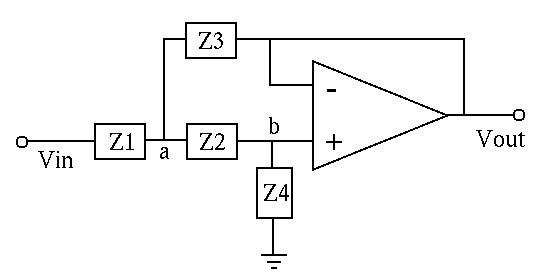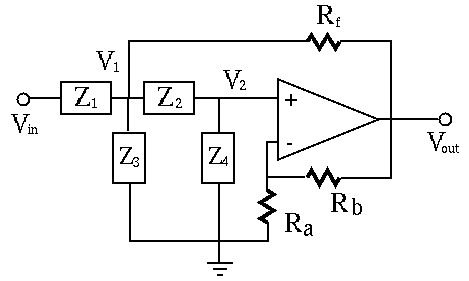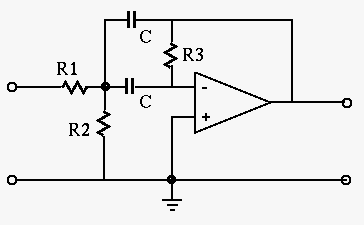Next: The Twin-T notch (band-stop) Up: Chapter 6: Active Filter Previous: First and Second Order
A Sallen-Key filter with the general configuration shown below is a second-order active filter that can be used to implement any of the low-pass, high-pass, and band-pass filtering.

To find the frequency response function of the filter, we find the output voltage
as a function of the input voltage both represented in phasor form, and apply the
virtual ground assumption

 (13)
(13)
 (14)
(14)
 , we get
, we get
 (15)
(15)
 (16)
(16)
 and
and  :
:
 |
 |
 |
(17) |
If we let 



 (18)
(18)
where
 (19)
(19)
 (20)
(20)
 and
and  or
or  of
a desired filter, we can arbitrarily set any two of the four variables
of
a desired filter, we can arbitrarily set any two of the four variables  ,
,
 ,
,  , and
, and  , and then solve for the other two. For example,
for convenience, if we let
, and then solve for the other two. For example,
for convenience, if we let  , we get
, we get
 (21)
(21)
If we let




 (22)
(22)
 (23)
(23)
 (24)
(24)

By voltage divider and virtual ground, we get
 (25)
(25)
 to get:
to get:
 (26)
(26)
 to get:
to get:
 (27)
(27)
 for
for  we get
we get
 |
|||
 |
 |
(28) |
 by
by  to get
to get
![$\displaystyle \frac{V_{in}}{Z_1}+\frac{V_{out}}{R_f}
=kV_{out}\left[\left(1+\f...
...{Z_1}+\frac{1}{R_f}
+\frac{1}{Z_2}+\frac{1}{Z_3}\right)-\frac{1}{Z_2}\right]
$](img103.svg) (29)
(29)
 |
 |
![$\displaystyle kV_{out}\left[\left(1+\frac{Z_2}{Z_4}\right)
\left(\frac{1}{Z_1}
...
..._f}+\frac{1}{Z_2}+\frac{1}{Z_3}\right)-\frac{1}{Z_2}\right]-\frac{V_{out}}{R_f}$](img105.svg) |
|
 |
![$\displaystyle V_{out}\left\{k\left[\left(1+\frac{Z_2}{Z_4}\right)\left(\frac{1}...
...}+\frac{1}{Z_2}+\frac{1}{Z_3}\right)-\frac{1}{Z_2}\right]-\frac{1}{R_f}\right\}$](img106.svg) |
(30) |
 |
 |
![$\displaystyle \frac{1}{Z_1\left\{k\left[\left(1+\frac{Z_2}{Z_4}\right)\left(\fr...
...+\frac{1}{Z_2}+\frac{1}{Z_3}\right)-\frac{1}{Z_2}\right]-\frac{1}{R_f}\right\}}$](img108.svg) |
|
 |
![$\displaystyle \frac{1/k}{Z_1\left[\left(1+\frac{Z_2}{Z_4}\right)\left(\frac{1}{...
...{R_f}+\frac{1}{Z_2}+\frac{1}{Z_3}\right)-\frac{1}{Z_2}\right]-\frac{Z_1}{kR_f}}$](img109.svg) |
||
 |
 |
(31) |
 (32)
(32)
 |
 |
 |
|
 |
 |
(33) |
 (34)
(34)
 (35)
(35)
 .
.
Example:

where

